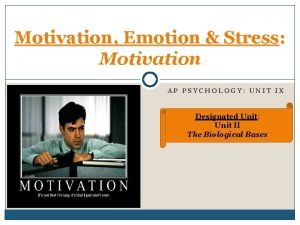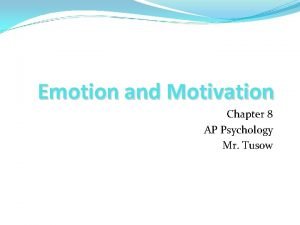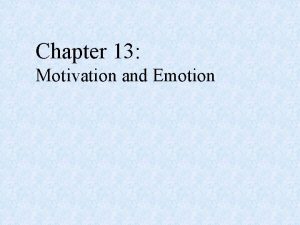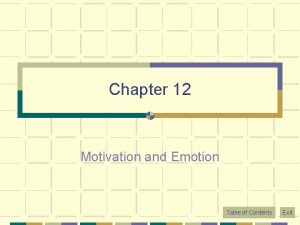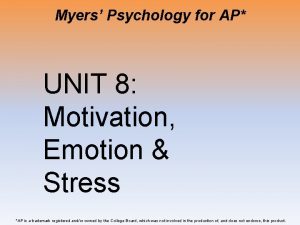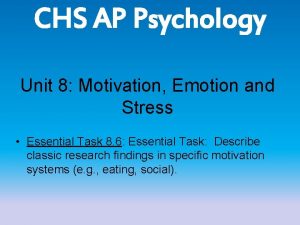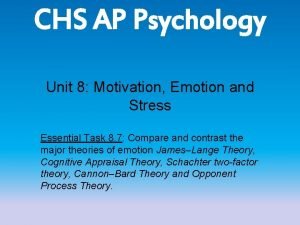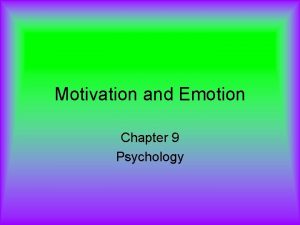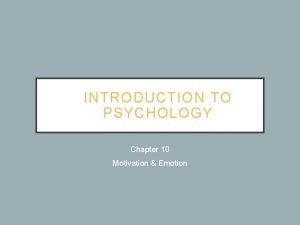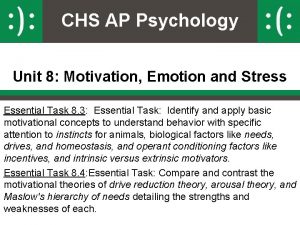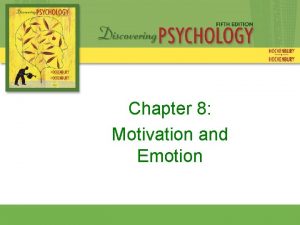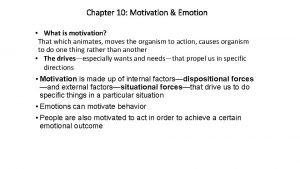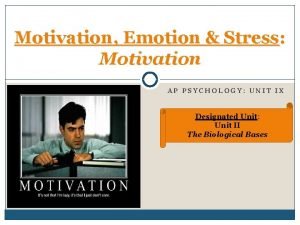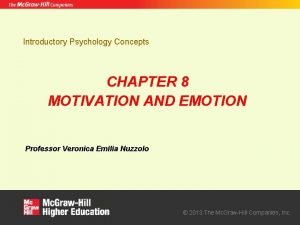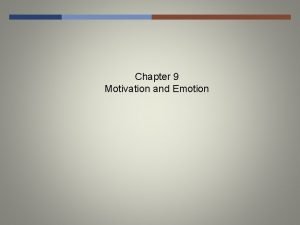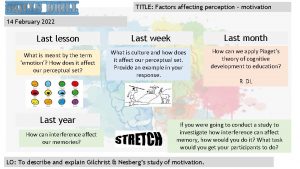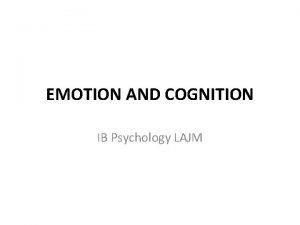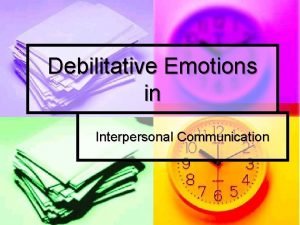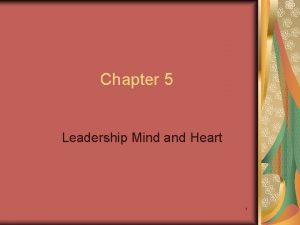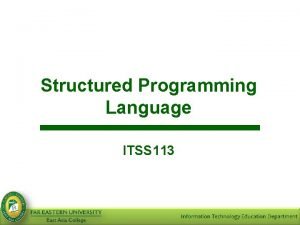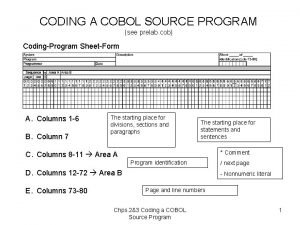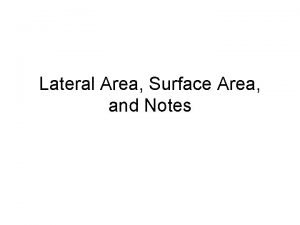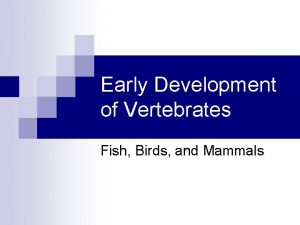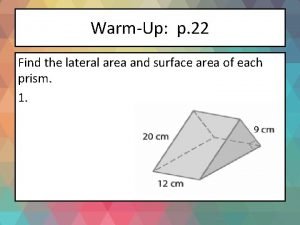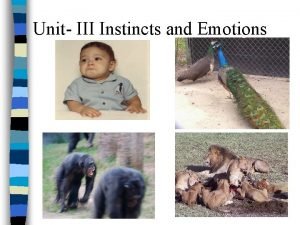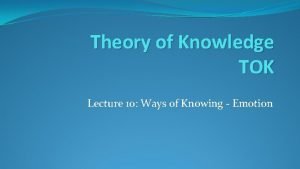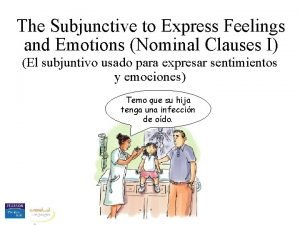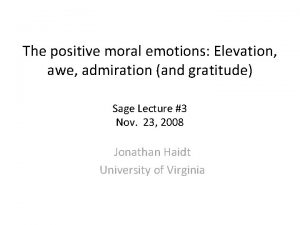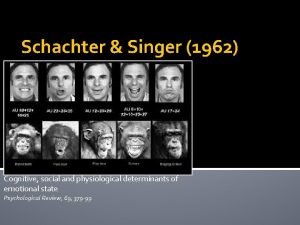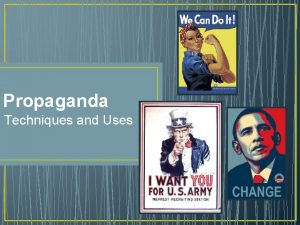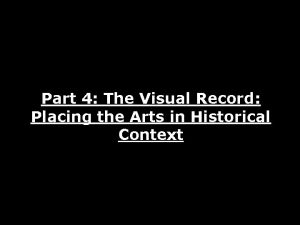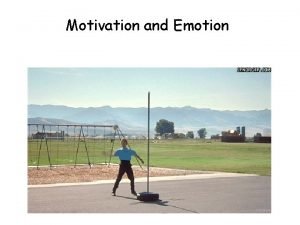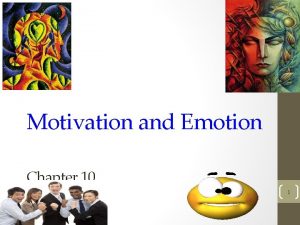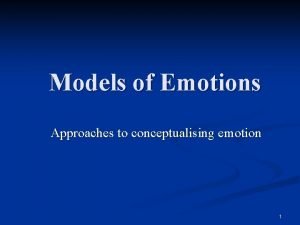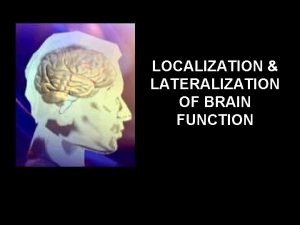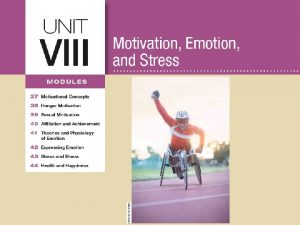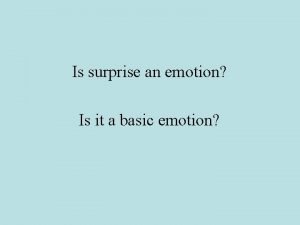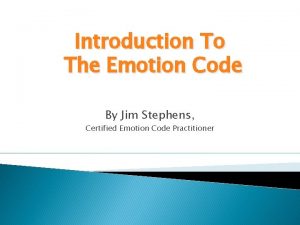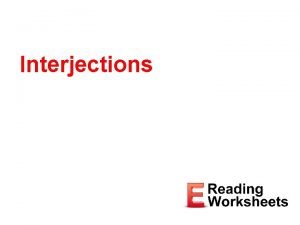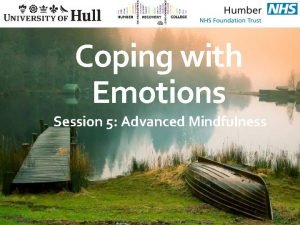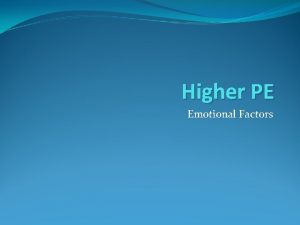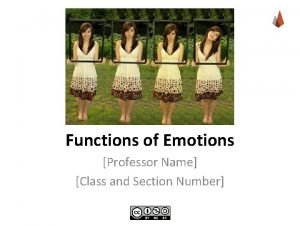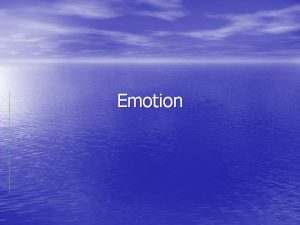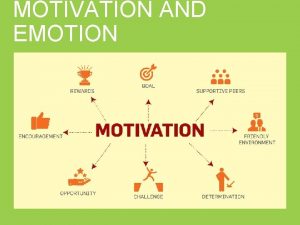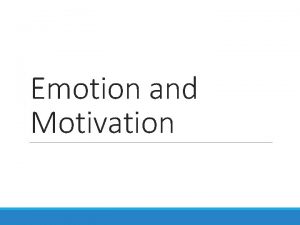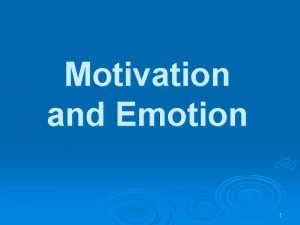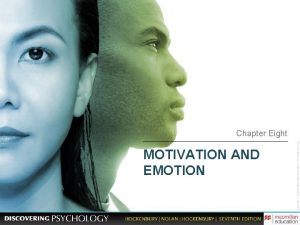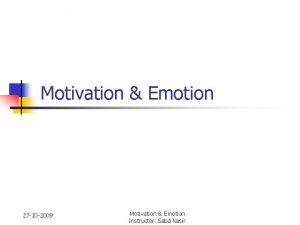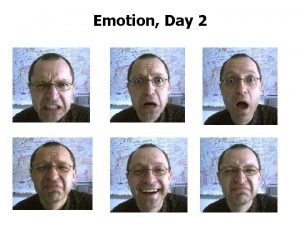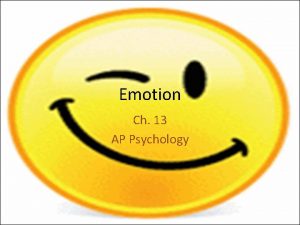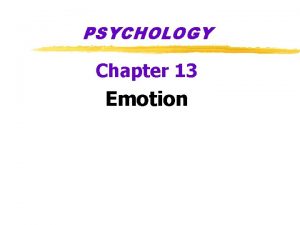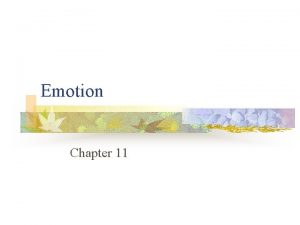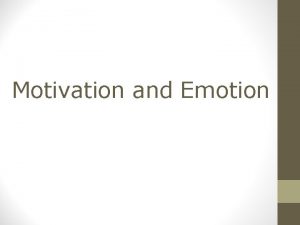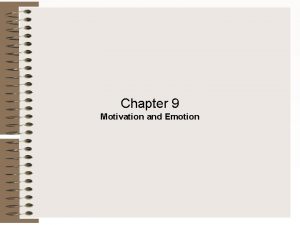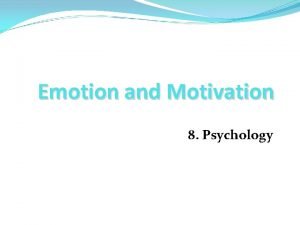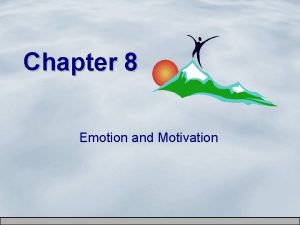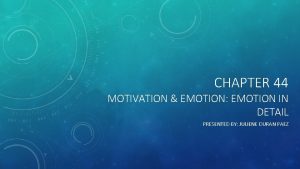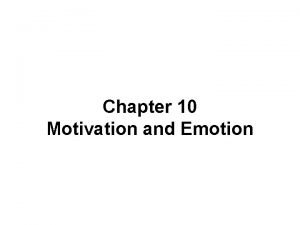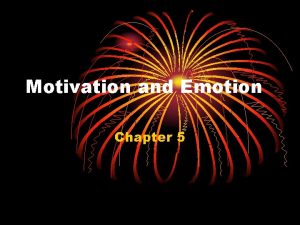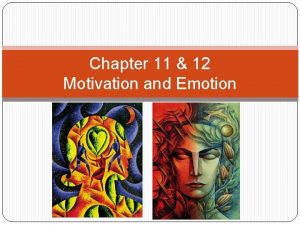Study Area 9 Motivation and Emotion Motivation Motivation




















































- Slides: 52

Study Area 9 Motivation and Emotion

Motivation • Motivation: the process by which activities are started, directed, and continued so that physical or psychological needs or wants are met – extrinsic motivation: a person performs an action because it leads to an outcome that is separate from or external to the person – intrinsic motivation: a person performs an action because the act is fun, challenging, or satisfying in an internal manner

Instinct Approaches to Motivation • Instincts: the biologically determined and innate patterns of behavior that exist in both people and animals • Instinct approach: approach to motivation that assumes people are governed by instincts similar to those of animals

Drive-Reduction Theory of Motivation • the first theory for motivation • Drive theories of motivation are based on the concept of drives, which are hypothetical states of tension or discomfort that motivate (or ‘drive’) an organism to engage in behaviors that will maintain a state of physiological stability (homeostasis). The theories have been influential but also have limitations, in that they do not necessarily provide an adequate explanation for all types of behavior.

Drive-Reduction Theory of Motivation • Drive-reduction theory: assumes behavior arises from physiological needs that cause internal drives to push the organism to satisfy the need and reduce tension and arousal

Drive-Reduction Theory of Motivation • Note: While the drive-reduction theory of motivation was once a Note: dominant force in psychology, it is largely ignored today. Despite this, it is worthwhile for students to learn more about Hull’s ideas in order to understand the effect his work had on psychology and to see how other theorists responded by proposing their own theories. • Need: a requirement of some material (such as food or water) that is essential for survival of the organism • Drive: a psychological tension and physical arousal arising when there is a need that motivates the organism to act in order to fulfill the need and reduce the tension

Drive-Reduction Theory of Motivation • Primary drives: involve needs of the body such as hunger and thirst • Acquired (secondary) drives: learned through experience or conditioning, such as the need for money or social approval • Homeostasis: the tendency of the body to maintain a steady state

Homeostasis In homeostasis, the body maintains balance in the body’s physical states. For example, this diagram shows how increased hunger (a state of imbalance) prompts a person to eat. Eating increases the level of glucose (blood sugar), causing the feelings of hunger to reduce. After a period without eating, the glucose levels become low enough to stimulate the hunger drive once again, and the entire cycle is repeated.

Three Types of Needs • Need for achievement (n. Ach): involves a strong desire to succeed in attaining goals—not only realistic ones, but also challenging ones • Need for affiliation (n. Aff): the need for friendly social interactions and relationships with others • Need for power (n. Pow): the need to have control or influence over others Mc. Clelland's Human Motivation Theory is also known as Three Needs Theory, Acquired Needs Theory, Motivational Needs Theory, and Learned Needs Theory.

Arousal Approach to Motivation • Stimulus motive: a motive that appears to be unlearned but causes an increase in stimulation, such as curiosity • Arousal theory: theory of motivation in which people are said to have an optimal (best or ideal) level of tension that they seek to maintain by increasing or decreasing stimulation

Arousal Approach to Motivation • Yerkes-Dodson law: law stating performance is related to arousal; moderate levels of arousal lead to better performance than do levels of arousal that are too low or too high – This effect varies with the difficulty of the task § easy tasks require a high-moderate level § more difficult tasks require a low-moderate level

Arousal and Performance The optimal level of arousal for task performance depends on the difficulty of the task. We generally perform easy tasks well if we are at a high–moderate level of arousal (green) and accomplish difficult tasks well if we are at a low– moderate level (red).

Arousal Approach to Motivation Sensation seeker: one who needs more arousal than the average person. Sensation seeking is a personality trait defined by the search for experiences and feelings, that are "varied, novel, complex and intense", and by the readiness to "take physical, social, legal, and financial risks for the sake of such experiences. "


Incentive Approaches to Motivation • Incentives: things that attract or lure people into action • Incentive approaches: theories of motivation in which behavior is explained as a response to the external stimulus and its rewarding properties

Maslow’s Hierarchy of Needs • Self-actualization: the point at which people have sufficiently satisfied the lower needs and achieved their full human potential - seldom reached • Peak experiences: times in a person’s life during which self-actualization is temporarily achieved Drive-Reduction Theory of Motivation expanded

Maslow's hierarchy of needs

Maslow’s Hierarchy of Needs Maslow proposed that human beings must fulfill the more basic needs, such as physical and security needs, before being able to fulfill the higher needs of selfactualization and transcendence.

Self-Determination Theory of Motivation • Self-determination theory (SDT): the social context of an action has an effect on the type of motivation existing for the action. Concerns people's inherent growth tendencies and innate psychological needs. It is concerned with the motivation behind choices people make without external influence and interference. • Intrinsic motivation: type of motivation in which a person performs an action because the act itself is rewarding or satisfying in some internal manner

Hunger: Bodily Causes • Insulin and glucagon: hormones secreted by the pancreas to control levels of fats, proteins, and carbohydrates in the bloodstream – insulin reduces the level of glucose in the bloodstream – glucagon increases the level of glucose in the bloodstream • Leptin: hormone that signals the hypothalamus that the body has had enough food and reduces the appetite while increasing the feeling of being full

Hunger: Bodily Causes • Hypothalamus plays role in hunger – responds to levels of glucose & insulin in the body – leptin: hormone that signals the hypothalamus that the body has had enough food and reduces the appetite while increasing the feeling of being full

Obese Laboratory Rat The rat on the left has reached a high level of obesity because its ventromedial hypothalamus has been deliberately damaged in the laboratory. The result is a rat that no longer receives signals of being satiated, and so the rat continues to eat and eat.

Hunger: Bodily Causes • Weight set point: the particular level of weight that the body tries to maintain • Basal metabolic rate (BMR): the amount of energy expended while at rest in a neutrally temperate environment, in the post-absorptive state (meaning that the digestive system is inactive, which requires about twelve hours of fasting). . • Basal Metabolic Rate (BMR); the number of calories you'd burn if you stayed in bed all day. • BMR decreases with age and with the loss of lean body mass. • Daily Calorie Needs are based on your activity level.


BMR The Harris Benedict Equation is a formula that uses your BMR and then applies an activity factor to determine your total daily energy expenditure (calories). The only factor omitted by the Harris Benedict Equation is lean body mass. Remember, leaner bodies need more calories than less leaner ones.

Hunger: Social Causes • Social cues for when meals are to be eaten – Cultural customs – Food preferences – Use of food as a comfort device or escape from unpleasantness § Some people may respond to the anticipation of eating by producing an insulin response

Obesity • Obesity: the body weight of a person is 20 percent or more over the ideal body weight for that person’s height (actual percents vary across definitions) – biological causes include heredity, hormones, and slowing metabolism with age – overeating is a major factor as food supplies stabilize in developing countries and Westernculture lifestyles are adopted

Obesity BMI is a person's weight in kilograms (kg) divided by his or height in meters squared. The National Institutes of Health (NIH) now defines normal weight, overweight, & obesity according to BMI rather than the traditional height/weight charts.

Obesity BMI is a person's weight in kilograms (kg) divided by his or height in meters squared. The National Institutes of Health (NIH) now defines normal weight, overweight, & obesity according to BMI rather than the traditional height/weight charts.

Elements of Emotion • Emotion: the “feeling” aspect of consciousness characterized by: – certain physical arousal – certain behavior that reveals the emotion to the outside world – inner awareness of feelings Emotion, in everyday speech, is any relatively brief conscious experience characterized by intense mental activity and a high degree of pleasure or displeasure. Scientific discourse has drifted to other meanings and there is no consensus on a definition. Emotion is often intertwined with mood, temperament, personality, disposition, and motivation.

Elements of Emotion • Which parts of the brain are involved in various aspects of emotion? – The amygdala § the amygdala is a complex structure with many different nuclei and subdivisions, whose roles have been investigated primarily through studies of fear conditioning § emotional stimuli travel to the amygdala by both a fast, crude “low road” (subcortical) and a slower but more involved cortical “high road”

The “Low Road” and “High Road” When we are exposed to an emotion-provoking stimulus (such as a shark), the neural signals travel by two pathways to the amygdala. The “low road” is the pathway underneath the cortex and is a faster, simpler path, allowing for quick responses to the stimulus, sometimes before we are consciously aware of the nature of the stimulus. The “high road” uses cortical pathways and is slower and more complex, but it allows us to recognize threat and, when needed, take more conscious control of our emotional responses. In this particular example, the low road shouts, “Danger!” and we react before the high road says, “It’s a shark!”

Elements of Emotion • Which parts of the brain are involved in various aspects of emotion? – other subcortical and cortical areas § hemisphere § frontal lobes § anterior cingulate cortex § lateral orbitofrontal cortex;

Emotion • Psychological research has classified six facial expressions which correspond to six distinct universal emotions: • disgust, • sadness, • happiness, • fear, • anger, and • surprise

Facial Expressions of Emotion Facial expressions appear to be universal. For example, these faces are consistently interpreted as showing (a) anger, (b) fear, (c) disgust, (d) happiness, (e) surprise, and (f) sadness by people of various cultures from all over the world. Although the situations that cause these emotions may differ from culture to culture, the expression of particular emotions remains strikingly the same.

Facial expressions appear to be universal. Which of the six basic expressions is this? Its disgusting.

Facial expressions appear to be universal. Which of the six basic expressions is this? Its happy time.

Facial expressions appear to be universal. Which of the six basic expressions is this? Its fear.

Facial expressions appear to be universal. Which of the six basic expressions is this? Its surprising.

Facial expressions appear to be universal. Which of the six basic expressions is this? Its sad.

Facial expressions appear to be universal. Which of the six basic expressions is this? I am angry.

Elements of Emotion • Facial expressions can vary across different cultures - people from different cultures perceive happy, sad or angry facial expressions in unique ways, according to new research published by the American Psychological Association. – Have been thought to be universal – display rules - although facial expressions are pretty universal across the world, emotional display rules, in terms of how much emotion you should express, tend to vary greatly across cultures. • Labeling Emotion – Interpreting the subjective feeling by giving it a label

Theories of Emotion

Common Sense Theory of Emotion • Common sense theory of emotion: a stimulus leads to an emotion, which then leads to bodily arousal

James-Lange Theory of Emotion James-Lange theory of emotion: a physiological reaction leads to the labeling of an emotion

Cannon-Bard Theory of Emotion Cannon-Bard theory of emotion: the physiological reaction and the emotion are assumed to occur at the same time

Cognitive Arousal Theory of Emotion Cognitive arousal theory: both the physical arousal and the labeling of that arousal based on cues from the environment must occur before the emotion is experienced Schachter and Singer’s cognitive arousal theory is similar to the James-Lange theory but adds the element of cognitive labeling of the arousal. In this theory, a stimulus leads to both bodily arousal and the labeling of that arousal (based on the surrounding context), which leads to the experience and labeling of the emotional reaction.

Facial Feedback Hypothesis • Facial feedback hypothesis: facial expressions provide feedback to the brain concerning the emotion being expressed, which in turn causes and intensifies the emotion In the facial feedback theory of emotion, a stimulus such as this snarling dog causes arousal and a facial expression. The facial expression then provides feedback to the brain about the emotion. The brain then interprets the emotion and may also intensify it.

Cognitive Mediational Theory Cognitive-mediational theory: a stimulus must be interpreted (appraised) by a person in order to result in a physical response and an emotional reaction In Lazarus’s cognitive-mediational theory of emotion, a stimulus causes an immediate appraisal (e. g. , “The dog is snarling and not behind a fence, so this is dangerous”). The cognitive appraisal results in an emotional response, which is then followed by the appropriate bodily response.

Comparison of Theories of Emotion

Comparison of Theories of Emotion (Cont’d) This theory has clearly been the most widely accepted theory of emotion.

The End – Study Area 9 Motivation and Emotion
 Arousal theory ap psychology
Arousal theory ap psychology 2 factor theory of emotion
2 factor theory of emotion Chapter 13 motivation and emotion
Chapter 13 motivation and emotion Chapter 12 motivation and emotion
Chapter 12 motivation and emotion Bulimia nervosa definition ap psychology
Bulimia nervosa definition ap psychology Unit 8 motivation and emotion
Unit 8 motivation and emotion Two factor theory psychology
Two factor theory psychology Carroll izard 10 basic emotions
Carroll izard 10 basic emotions Chapter 10 motivation and emotion
Chapter 10 motivation and emotion Ap psychology unit 8 motivation emotion and stress
Ap psychology unit 8 motivation emotion and stress Cognitive appraisal
Cognitive appraisal Chapter 10 motivation and emotion
Chapter 10 motivation and emotion Unit 8 motivation and emotion
Unit 8 motivation and emotion Ap psychology unit 8 motivation emotion and stress
Ap psychology unit 8 motivation emotion and stress Chapter 8 motivation and emotion
Chapter 8 motivation and emotion Psychology chapter 9 motivation and emotion
Psychology chapter 9 motivation and emotion Chapter 9 motivation and emotion
Chapter 9 motivation and emotion Gilchrist and nesburg study of motivation
Gilchrist and nesburg study of motivation Teacup ib psychology
Teacup ib psychology Facilitative emotions examples
Facilitative emotions examples Leadership mind and emotion
Leadership mind and emotion Cobol area a and area b
Cobol area a and area b Ibm system/390
Ibm system/390 Volume and surface area of cone
Volume and surface area of cone Cobol cheat sheet
Cobol cheat sheet Leteral area
Leteral area Lateral surface area def
Lateral surface area def Gastrulation
Gastrulation Lateral edge
Lateral edge Method study in management
Method study in management Time study objectives
Time study objectives Distinguish between time study and motion study
Distinguish between time study and motion study Mcdougall theory of emotion
Mcdougall theory of emotion Tok emotion
Tok emotion Physiological theory of emotion
Physiological theory of emotion Emotions subjunctive
Emotions subjunctive Elevation emotion
Elevation emotion Which of the following best describes task performance?
Which of the following best describes task performance? Schachter and singer sample
Schachter and singer sample Repetition propaganda examples in the philippines
Repetition propaganda examples in the philippines Narmer palette meaning
Narmer palette meaning Which of the following factors stimulate us to eat?
Which of the following factors stimulate us to eat? The of an emotion refers to whether it feels pleasant
The of an emotion refers to whether it feels pleasant Emotions and moods
Emotions and moods Lateralization of emotion
Lateralization of emotion Zajonc and ledoux theory
Zajonc and ledoux theory Basic emotion
Basic emotion Heart wall emotion code
Heart wall emotion code Excitement interjection
Excitement interjection Uncontrollable outburst of fear
Uncontrollable outburst of fear Humber recovery college
Humber recovery college Higher pe factors
Higher pe factors Function of emotions
Function of emotions
